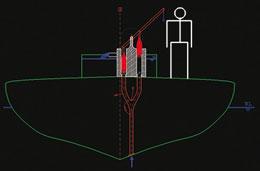Roman ship had on-board fish tank
- On 01/06/2011
- In Underwater Archeology
- 0 comments

The Nautical Archaeology Society
By Jo Marchant - Nature
A Roman ship found with a lead pipe piercing its hull has mystified archaeologists.
Italian researchers now suggest that the pipe was part of an ingenious pumping system, designed to feed on-board fish tanks with a continuous supply of oxygenated water.
Their analysis has been published online in the International Journal of Nautical Archaeology.
Historians have assumed that in ancient times fresh fish were eaten close to where they were caught, because without refrigeration they would have rotted during transportation. But if the latest theory is correct, Roman ships could have carried live fish to buyers across the Mediterranean Sea.
The wrecked ship, which dates from the second century AD, was discovered six miles off the coast of Grado in northeastern Italy, in 1986.
It was recovered in pieces in 1999 and is now held in the Museum of Underwater Archaeology in Grado. A small trade ship around 16.5 metres long, the vessel was carrying hundreds of vase-like containers that held processed fish, including sardines and salted mackerel.
Carlo Beltrame, a marine archaeologist at the Ca' Foscari University of Venice in Italy, and his colleagues have been trying to make sense of one bizarre feature of the wreck: a lead pipe near the stern that ends in a hole through the hull. The surviving pipe is 1.3 metres long, and 7–10 centimetres in diameter.
The team concludes that the pipe must have been connected to a piston pump, in which a hand-operated lever moves pistons up and down inside a pair of pipes. One-way valves ensure that water is pushed from one reservoir into another. The Romans had access to such technology, although it hasn't been seen before on their ships, and the pump itself hasn't been recovered from the Grado wreck.
Mediterranean sea museum Roman
Add a comment